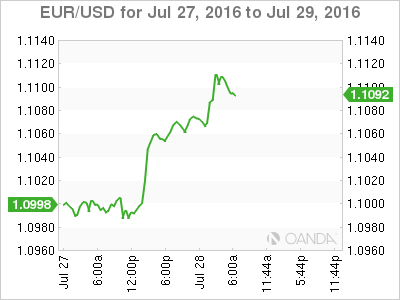The euro has posted gains on Thursday, continuing the upward movement which marked the Wednesday session. EUR/USD is currently trading at the 1.11 line. On the release front, German unemployment posted a stronger decline than expected. Later in the day, Germany releases Preliminary CPI. In the US, today’s highlight is Unemployment Claims, with the indicator expected to rise to 261 thousand.
Friday will be busy, with the Eurozone releasing CPI Flash Estimate and the EBA Bank Stress Test results. The US will publish Advance GDP, with the markets expecting a banner reading of 2.6%. We’ll also get a look at UoM Consumer Sentiment, which is expected to drop to 90.3 points.
There were no surprises from the Federal Reserve, which concluded its policy meeting on Wednesday. The bank continued to hold the course on interest rates, maintaining levels at 0.25% in a 9-1 vote. The Fed statement sounded upbeat, saying that risks to the economy have receded and the employment market is getting tighter.
The Fed added that it continues to monitor inflation levels and noted that the housing sector had improved. Will the Fed make a move and raise rates in September? It appears that the Fed could go either way, and policymakers will make a decision at the September meeting based on US economic releases. This means that key US numbers, such as Friday’s Advance GDP report, will be under the market microscope, and unexpected readings could lead to strong volatility in the currency markets.
The ECB continues to hold the course on monetary policy, and held rates at 0.00% at last week’s policy meeting. ECB head Mario Draghi trotted out his well-worn message that the bank stood ready to act “using all the instruments available within its mandate”. The Eurozone economy remains soft and continues to grapple with very low inflation, so there is pressure on the bank to adopt further stimulus measures.
The situation has become further complicated with the recent Brexit vote which sent the financial markets into turmoil. Britain, the second largest economy in Europe, will soon commence negotiations with the European Union over Britain’s exit from the club. Recent data in both the UK and Europe point to weaker consumer indicators, and upcoming data will allow the markets to begin to gauge the effect of Brexit on the Eurozone and British economies.
In the wake of Brexit, the EU and Britain will have to hammer out and a new economic relationship and any developments with regard to the negotiations could clarify matters and lend some stability to the markets. So far, however, the only certainty is that negotiations will not commence anytime soon, as the British government has said that it will not invoke the exit mechanism (Article 50 of the Treaty of Lisbon) before the end of 2016.
EUR/USD Fundamentals
Thursday (July 28)
- All Day – German Preliminary CPI. Estimate 0.2%
- 7:00 Spanish Employment Rate. Estimate 20.5%. Actual 20.0%
- 7:55 German Unemployment Change. Estimate -3K. Actual -7K
- Tentative – Italian 10-year Bond Auction
- 12:30 US Unemployment Claims. Estimate 261K
- 14:30 US Natural Gas Storage. Estimate 29B
Upcoming Key Events
Friday (July 29)
- 9:00 Eurozone CPI Flash Estimate. Estimate 0.1%
- 12:30 US Advance GDP. Estimate 2.6%
- 14:00 US Revised UoM Consumer Sentiment. Estimate 90.2
- 20:00 Eurozone EBA Bank Stress Test Results
* Key releases are in bold
*All release times are GMT
EUR/USD for Thursday, July 28, 2016

EUR/USD July 28 at 9:20 GMT
Open: 1.1066 High: 1.1120 Low: 1.1056 Close: 1.1101
EUR/USD Technical
| S1 | S2 | S1 | R1 | R2 | R3 |
| 1.0821 | 1.0925 | 1.1054 | 1.1150 | 1.1278 | 1.1376 |
- EUR/USD was flat in the Asian session and has posted considerable gains in the European session
- 1.1054 is providing support
- There is resistance at 1.1150
Further levels in both directions:
- Below: 1.1054, 1.0925, 1.0821 and 1.0708
- Above: 1.1150, 1.1278 and 1.1376
- Current range: 1.1054 to 1.1150
OANDA’s Open Positions Ratio
EUR/USD ratio has shown gains towards short positions. Currently, short positions have a strong majority (57%), indicative of trader bias towards EUR/USD reversing directions and moving downwards.
